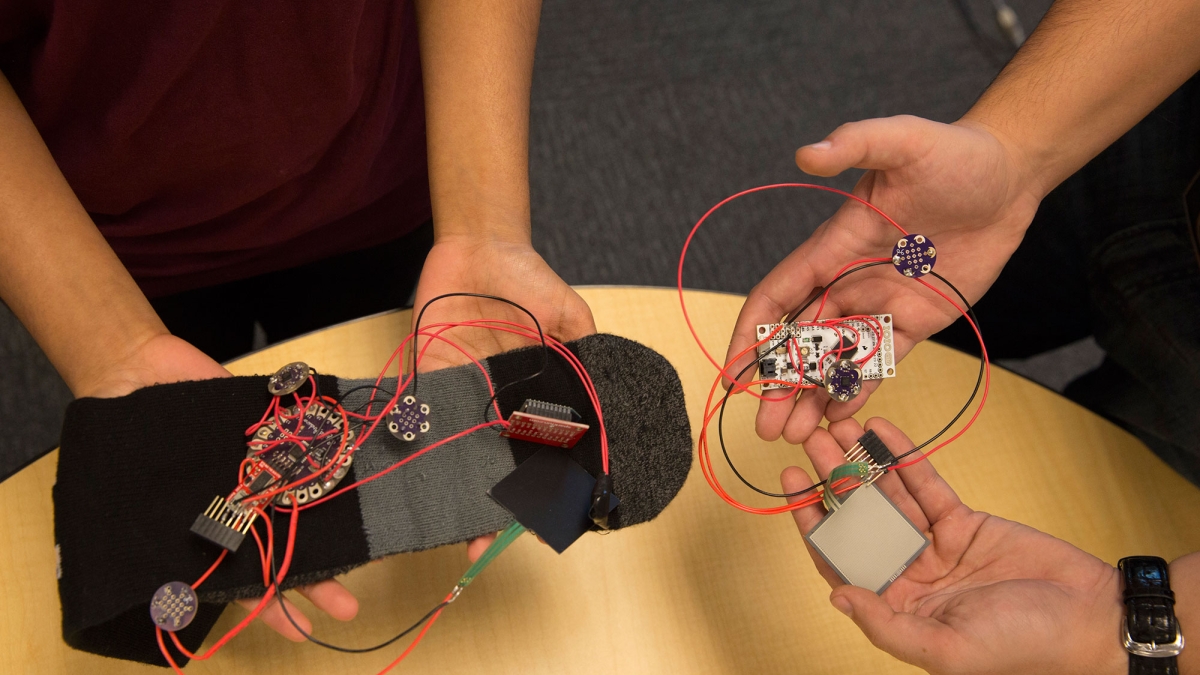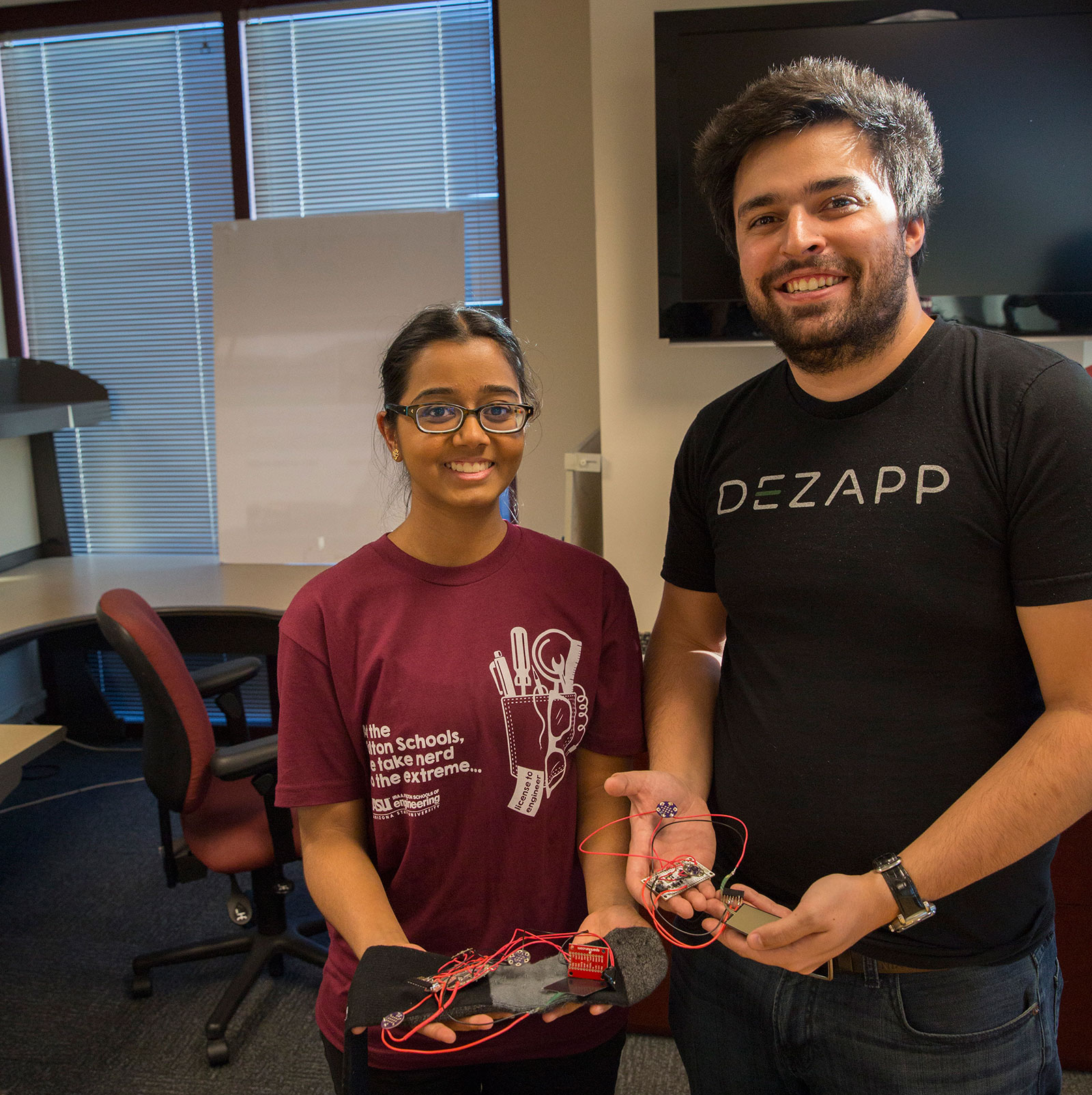Undergraduate research — with more than 1,000 students participating — is booming in the Ira A. Fulton Schools of Engineering at Arizona State University. But what about opportunities for high schoolers who want to get a jump-start on conducting research?
Shreya Venkatesh, a senior at BASIS Scottsdale charter school, is taking full advantage of an opportunity to get involved at the Center for Cognitive Ubiquitous Computing (CUbiC) — and winning prestigious awards in the process.
Her research interests surround assistive technologies, aligning with CUbiC’s role as an interdisciplinary research center focused on cutting-edge research in human-centered computing with assistive, rehabilitative and health-care applications.
Under the mentorship of ASU assistant research professor Troy McDaniel and computer science doctoral student Arash Tadayon, Venkatesh is helping to create a wearable device to help individuals with Parkinson’s disease manage a common symptom known as Freezing of Gait.
Alleviating Parkinson’s disease symptom
Freezing of Gait manifests itself in an individual’s sudden inability to continue their gait (walking stride).
“It is an episodic phenomenon that causes an individual’s feet to freeze up and feel like they’re glued to the floor,” Tadayon said.
Unfortunately, this symptom often occurs during high stress or timed tasks such as walking in a crosswalk.
“Our work looks to predict when these episodes are going to occur and bring the individual’s attention to it,” Tadayon said.
If the user is aware of the freeze before it occurs, warning them to take longer steps can often help prevent the full freeze from happening.
Auditory and visual cues have been previously used to guide the user to take longer steps, but the CUbiC team’s approach is exploring the field of haptics, specifically sensory vibrations as a feedback tool.
They are creating a device (pictured at the top of this story) that can be worn on the foot to collect and send out these sensory signals.
“It identifies the earliest onset of Freeze of Gait, then helps the wearer to pick up their pace by directing the user’s attention to their gait,” Venkatesh said.
When the project started, she mostly assisted with literature reviews, but she is now actively involved in developing the device’s software, including creating the algorithms, known as vibrotactile patterns, which send specific cues to the patient.
The team is working on designing and programming the patterns and will soon be planning another user study to test their effectiveness.
This project aligns with CUbiC’s larger aims to meet the needs and enrich the lives of physically challenged individuals by empowering them with ubiquitous and pervasive computing technologies.
“Using something artificial like technology to influence something as natural as human illness is fascinating,” said Venkatesh, who has enjoyed seeing up close the way technology can be employed to help improve human health.
High school student Shreya Venkatesh is mentored by doctoral student Arash Tadayon in the Center for Cognitive Ubiquitous Computing (CUbiC) Lab at ASU. This and top photo by Pete Zrioka/ASU
Awards include White House nod
Venkatesh has earned several notable awards since she began working with CUbiC in October 2014.
She received a Young Scientist of Arizona Award from Phoenix Comicon at the Arizona Science and Engineering Fair (AzSEF) — a statewide science fair competition — for her research in Freezing of Gait in April and was later invited to present a talk on this research area at a Phoenix Comicon panel in June.
She also earned an Outstanding Young Female Scientist in Systems Software award from the Association for Women in Science at AzSEF.
Last year, as a junior, Venkatesh received recognition from President Barack Obama for an outstanding achievement in environmental stewardship, for her research on a plant known as Jatropha whose seeds can be used to produce clean biodiesels.
Venkatesh performed an economic analysis of the comparative fuel efficiency of Jatropha biodiesel with algal biofuel production. She took the initiative to contact local communities and the EPA, creating awareness about the importance of cultivating Jatropha plantations within the United States.
Venkatesh presented her Jatropha project and earned a silver medal at the International Environmental Global Environmental Issues’ Science Olympiad in New York City, an international high school project competition focused on environmental issues. Her project was among more than 1,000 projects submitted from 69 countries.
Using computer science for social good
Venkatesh’s passion for computer science extends outside the research lab.
Since 2014, she has sought opportunities to introduce non-native English speakers and refugees throughout Scottsdale to coding. In March, she began volunteering for the Refugee Code Academy as a student ambassador. In this role she teaches basic coding to students and refugees, showing them the fun side of coding as well as its potential to solve many real-world problems.
Venkatesh also started a Google CS First club at her school, which introduces fourth- through sixth-graders to computer science concepts by creating fun applications and games.
Venkatesh’s passion for computer science is supported by her parents, who both work in the information technology sector. Her mother, Usha Jagannathan, is a lecturer in the Polytechnic School, one of the Ira A. Fulton Schools of Engineering; she began working at ASU after her daughter joined CUbiC.
On the importance of promoting STEM fields to children and young adults, Jagannathan said, “Helping young people have fun in learning new skills will propel them through college, and that will have a positive impact across generations.
“Shreya’s efforts in working with the CUbiC team and also her initiatives taken for refugee communities to inculcate programming skills really makes me feel proud and happy as students like her are transforming lives.”
Investing in next-generation researchers
For Venkatesh, one of the most rewarding aspects of working with CUbiC has been sharing her passion for math and science research with others.
She says she was the only fifth-grader from her school to compete in the AzSEF science fair, but as she has gotten older her early interest in math and science has allowed her to jump-start strong connections in “a community that has the same interests as me.”
Ready to attend college next fall, Venkatesh is in the process of sending in college applications. She was quick to share that the first application she submitted was to ASU’s Barrett, the Honors College. She is also applying to several STEM-focused schools on the East Coast.
Venkatesh — who also competes in archery and performs Indian classical dance — is interested in biomedical or electrical engineering and computer science, but is also open to exploring other majors. Though she says wherever she chooses to go must offer “a strong research program connecting professors and students.”
She is grateful that ASU offers this emphasis and chooses to open its doors to young researchers.
“CUbiC is full of amazing faculty and student researchers — the fact that they want to extend their offerings to high school students shows their commitment to investing in scientific research.”
McDaniel echoes this statement, saying, “CUbiC engages high school students to tap the talent of these aspiring individuals with opportunities to flourish and make an impact.”
“It means everything to see experts in their field take an interest in inspiring a high school student,” Venkatesh said.
Sethuraman “Panch” Panchanathan, the executive vice president of the Knowledge Enterprise and chief research and innovation officer at ASU, is the director of CUbiC.
More Science and technology

Applied Materials invests in ASU to advance technology for a brighter future
For nearly 60 years, global giant Applied Materials has been hard at work engineering technology that continues to change how microchips are made.Their products power everything from flat-panel…

Meet ASU engineering students who are improving health care, computing and more
Furthering knowledge of water resource management, increasing the efficiency of manufacturing point-of-care health diagnostic tools and exploring new uses for emerging computer memory are just some…

Turning up the light: Plants, semiconductors and fuel production
What can plants and semiconductors teach us about fuel production?ASU's Gary Moore hopes to find out.With the aim of learning how to create viable alternatives to fossil-based fuels, Moore — an…



